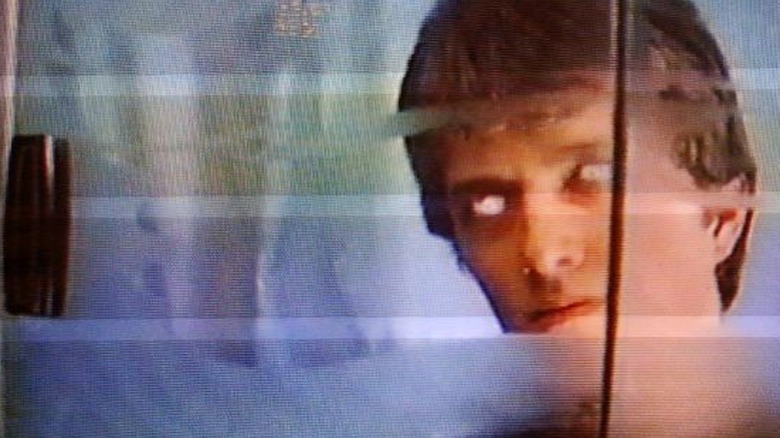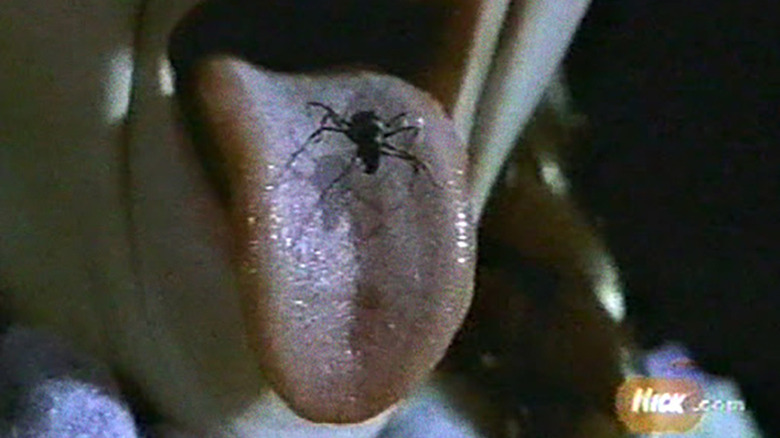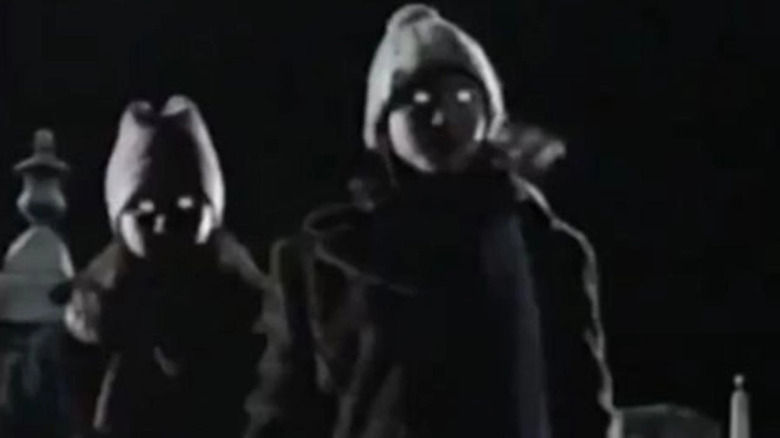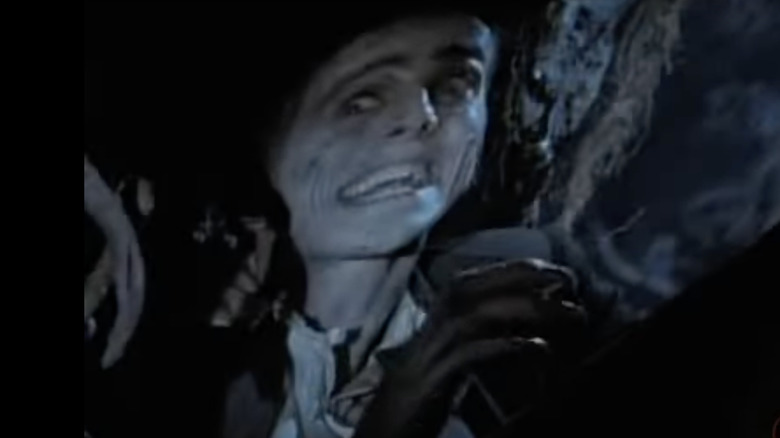The True Story Behind The 'Banned' Nickelodeon Horror Movie Cry Baby Lane
On October 28, 2000, kids all across America tuned into the Nickelodeon SNICK programming block to watch a new horror movie called "Cry Baby Lane." As bowls of microwaved popcorn flowed over, living room lights went down, and children gathered in front of the television, no one could have predicted that everyone watching would become a part of history. Directed by Peter Lauer ("The Adventures of Pete & Pete," "Arrested Development," "Scrubs"), "Cry Baby Lane" is about two brothers — the feeble Andrew (Jase Blankfort) and massive jerk Carl (Trey Rogers) — who love hearing ghost stories from the undertaker, Mr. Bennett (Frank Langella).
One night, the undertaker tells the story of a local farmer whose wife gave birth to conjoined twins (the movie uses the insensitive term "Siamese twins" because it was the year 2000), with one of the babies being noticeably evil. The farmer kept the twins locked up in an attic and away from the public eye before they eventually got sick and died together. The farmer then sawed the twins in half, burying the "good twin" in a cemetery and the "bad twin" in a shallow grave off the house on Cry Baby Lane. The brothers and a group of their friends decide to hold a seance outside the farmhouse to communicate with the good twin, but unintentionally awaken the evil twin by mistake. Now revived, the bad twin possesses everyone in town, including graveyard dogs, and Andrew must find a way to stop the evil.
"Cry Baby Lane" was supposed to be on the same scare level as a show like "Are You Afraid of the Dark," but the result was something so shocking, so terrifying that parents complained and Nickelodeon banned the film from ever airing again. The film became lost and locked away in the Nickelodeon vaults never to be seen again, until over a decade later when someone who had recorded the film off of the TV transferred their VHS footage to digital and uploaded it online.
At least, that's how legions of millennials remember it happening.
What really happened to Cry Baby Lane?
"Cry Baby Lane" was originally envisioned as a big-budget kids' horror movie, attempting to capture the same audience as "Casper," "Hocus Pocus," or even "The Monster Squad." Nickelodeon obtained the rights instead, and the film was dramatically scaled back to accommodate the made-for-TV production limitations. Because the film was originally only shown once and never made the jump to a physical media release, however, its existence became the subject of both a Mandela effect, as well as a modern urban legend. People who claimed to have watched "Cry Baby Lane" as children remembered it being so scary that they had nightmares for weeks, while others didn't believe the film ever existed at all. Fans started emailing Nickelodeon for information on the movie, but were allegedly told that the movie "didn't exist." This sparked countless conspiracy theories about the film, ranging from the believable — "Too many parents complained" — to the out of this world — "It was a cursed film so they banned it."
When this becomes the prevailing narrative surrounding the film, of course, people are going to fixate on the mysterious and more sensational possibility. The film's existence was confirmed in August of 2011 when now-deleted Reddit user "firesaladpeach" claimed to have a VHS copy of the film. Despite the clear copyright violation of digitizing and uploading the film online, Nickelodeon didn't seem to come after the Redditor, and instead decided to broadcast the film that October to capitalize off of the newly found hype.
Nickelodeon never took an official stance on the film being "banned," and it's assumed that it simply forgot it had the film in its archives since it was shown once and wasn't well received. However, once the film had been confirmed to exist, social media posts and ads for subsequent nostalgia replays of "Cry Baby Lane" were often advertised as a "banned film." A genuine interest from a bunch of people obsessively Googling for information became the best possible buzz Nickelodeon could have hoped for, but the urban legends surrounding the film didn't stop once it started showing the movie again.
The Cry Baby Lane Creepypasta
Google has made fact-checking easier than ever before, which means urban legends are harder to come by. Fortunately, the void of scary storytelling has been filled by Creepypastas, horror-related urban legends that are user-created and shared around the internet. The most famous Creepypasta is arguably Slender Man, but stories and creatures from famous Creepypastas were also used as inspirations for the hit horror series "Channel Zero." Creepypastas aren't exclusive to original creations, though, and are often centered on twisted takes of existing IP. Another Nickelodeon-based Creepypasta, "Squidward's Suicide," deals with an alleged faux-episode of "SpongeBob SquarePants" made as a joke by animators that caused viewers to take their lives. It's fake, obviously, but when the story makes the rounds enough on the internet to become distanced from its Creepypasta origins ... plenty of people start to believe it must be true.
"Cry Baby Lane" is the subject of its own Creepypasta, where an intern who worked at Nickelodeon at the time claimed that the version of the movie we all saw in 2000 is not the version that Nickelodeon has re-released nor is it the version that Redditors found and uploaded. In reality, the film truly was as depraved and terrifying as our collective memories would have us believe, and if the director had his way, it would have included graphic depictions of cannibalism and other not-so-child-friendly horrors subliminally interspersed between the frames. It's a great horror story, but one that is once again, not true.
But that doesn't stop a bunch of people from reading it online, believing it as fact, and running with the story as if it were gospel, only adding to the film's already scandalous legacy. Considering "Cry Baby Lane" the actual movie is about an urban legend come true, it's fitting that it would become an urban legend in and of itself.
Is Cry Baby Lane as scary as people claim?
As for the actual film, which has since been uploaded multiple times to YouTube as to not become a lost film once again, "Cry Baby Lane" is pretty dang corny, all things considered. While it does dabble with the pretty dark urban legend of conjoined twins being separated and the spirit of an evil twin possessing everyone in town, there are at least 10 episodes of "Are You Afraid of the Dark" that are infinitely more memorable and nightmare-inducing than "Cry Baby Lane." When people in town become possessed, their eyes become white and glow like something out of "Village of the Damned," but the ghost's possession essentially just turns everyone into a cruel jerkwad than anything particularly threatening. The film's score is just as bassoon-heavy as "AYAOTD," which was most definitely on purpose and likely gave younger viewers the creeps. Nevertheless, the scariest part about "Cry Baby Lane" is the urban legends that surround it.
Honestly, rewatching it is a lot like the end of "I Saw The TV Glow," wherein Owen rewatches his favorite show as a kid that he believed to be transcendent only to realize it was a heck of a lot cheaper and overwrought than he remembered. "Cry Baby Lane" has been kept alive by claims of it being "so scary it was banned," but the reality is that it's still incredibly tame and would likely be laughed at by today's kids (who see scarier imagery watching their favorite streamers play "Five Nights at Freddy's" or in the dead-eyed thumbnails of Mr. Beast videos).
If you want to watch a time capsule of forgotten kindertrauma, "Cry Baby Lane" is available all over the internet. Still, there's no shame in wanting to keep the mystique alive and allowing the film to exist only in your distorted memories or macabre imaginations.



